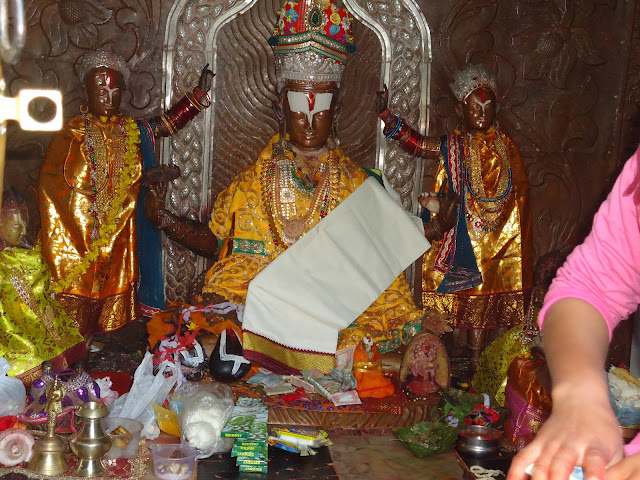திருப்புறம்பியம்
கரும்பன்ன சொல்லி தேவி உடனுறை சாட்சிநாதர் கோவில்
இது காவிரியின் வடகரைத் தலங்களில் ஒன்றாகும்.
கரும்பன்னசொல்லி தேவி

ரத்னாவல்லி என்ற பெண்ணின் பெற்றோர் அவளுக்கு திருமணம் நிச்சயம் செய்திருந்தனர். தவிர்க்க முடியாத காரணத்தினால் திருமணமாவதற்கு முன்பே தான் மணக்கவிருக்கும் பையனுடன் அவள் இவ்வூர் வந்தாள். வந்த இடத்தில் பாம்பு கடித்து அப்பையன் இறக்கவே, அங்கே வந்திருந்த திருஞானசம்பந்தர் அப்பையனை திரும்ப உயிர்பெறச் செய்தார். அதோடு, அப்பையனுக்கும், ரத்னாவல்லிக்கும் அவ்விடத்திலேயே திருமணம் செய்து வைத்தார். இதற்கு சாட்சியாக திரு சிவனும், வன்னிமரமும் இருந்தமையால் இறைவன் திரு சாட்சிநாதர் என பெயர் பெற்றார். இது திருவிளையாடல் புராணத்திலும் இடம் பெற்றிருக்கிறது.
சாட்சிநாதர்

சாட்சிநாதர், புன்னைவனநாதர் என்றும் அழைக்கப்படுகிறார். இவர் கிழக்கு நோக்கியுள்ளார். ஸ்வயம்பு மூர்த்தியாவார்.
திருநாவுக்கரசர் போற்றி பாடியது:
ப்ரளயம் காத்த விநாயகர்
இத்திருகோவிலுள்ள விநாயகர் பிரளயம் காத்த விநாயகர் என்று போற்றப்படுகிறார். மிக விசேஷமான தோற்றம் கொண்டவர். வருண தேவனால் கிளிஞ்சல் போன்ற பொருள்களால் செய்யபட்டவராகையால், விநாயகருக்கு பொதுவான அபிஷேகங்கள் கிடையாது. விநாயக சதுர்த்தி முந்தைய மாலையிலிருந்து தேன் அபிஷேகம் நடைபெறும். பக்தர்கள் அன்று அபிஷேகத்திற்காக தேன் சமர்பிப்பதை, விநாயகரின் மேல் ஒத்தி எடுக்கிறார்கள்.
முதற் பிரகாரத்தில் நால்வர், அகஸ்தியர், புலஸ்தியர், சனந்தனர், சனகர், விசுவாமித்திரர் தொழுதால் லிங்கங்கள் உள்ளன. இரண்டாவது பிரகாரத்தில் அம்பாள் சந்நிதி உள்ளது. கோவிலின் கிழக்கே உள்ள குளக்கரைக்கருகே தக்ஷிணாமூர்த்தி அருள்பாலிக்கிறார். சற்று மேலே சட்டைநாதர் சந்நிதி உள்ளது. ஆறுமுகனை குழந்தை வடிவில் தன் இடையில் தாங்கி நிற்கும் ஸ்ரீகுகாம்பிகை சந்நிதி சிறப்பு வாய்ந்தது.
திருபுறம்பியத்திற்கு கும்பகோணத்தில் இருந்தும், சுவாமிமலையில் இருந்தும் பேருந்துகள் உள்ளன. புளியஞ்சேரி பஸ் நிலையம் இவ்விருவூர்களுக்கும் நடுவில் இருக்கிறது.
கோவில் தரிசன நேரம்:
காலை 6 மணி - மதியம் 1 மணி வரை
மாலை 4 மணி - இரவு 8.30 மணி வரை
கரும்பன்ன சொல்லி தேவி உடனுறை சாட்சிநாதர் கோவில்
இது காவிரியின் வடகரைத் தலங்களில் ஒன்றாகும்.
கரும்பன்னசொல்லி தேவி

ரத்னாவல்லி என்ற பெண்ணின் பெற்றோர் அவளுக்கு திருமணம் நிச்சயம் செய்திருந்தனர். தவிர்க்க முடியாத காரணத்தினால் திருமணமாவதற்கு முன்பே தான் மணக்கவிருக்கும் பையனுடன் அவள் இவ்வூர் வந்தாள். வந்த இடத்தில் பாம்பு கடித்து அப்பையன் இறக்கவே, அங்கே வந்திருந்த திருஞானசம்பந்தர் அப்பையனை திரும்ப உயிர்பெறச் செய்தார். அதோடு, அப்பையனுக்கும், ரத்னாவல்லிக்கும் அவ்விடத்திலேயே திருமணம் செய்து வைத்தார். இதற்கு சாட்சியாக திரு சிவனும், வன்னிமரமும் இருந்தமையால் இறைவன் திரு சாட்சிநாதர் என பெயர் பெற்றார். இது திருவிளையாடல் புராணத்திலும் இடம் பெற்றிருக்கிறது.
சாட்சிநாதர்

சாட்சிநாதர், புன்னைவனநாதர் என்றும் அழைக்கப்படுகிறார். இவர் கிழக்கு நோக்கியுள்ளார். ஸ்வயம்பு மூர்த்தியாவார்.
திருநாவுக்கரசர் போற்றி பாடியது:
ப்ரளயம் காத்த விநாயகர்
இத்திருகோவிலுள்ள விநாயகர் பிரளயம் காத்த விநாயகர் என்று போற்றப்படுகிறார். மிக விசேஷமான தோற்றம் கொண்டவர். வருண தேவனால் கிளிஞ்சல் போன்ற பொருள்களால் செய்யபட்டவராகையால், விநாயகருக்கு பொதுவான அபிஷேகங்கள் கிடையாது. விநாயக சதுர்த்தி முந்தைய மாலையிலிருந்து தேன் அபிஷேகம் நடைபெறும். பக்தர்கள் அன்று அபிஷேகத்திற்காக தேன் சமர்பிப்பதை, விநாயகரின் மேல் ஒத்தி எடுக்கிறார்கள்.
பிரளயம் காத்த விநாயகர்
முதற் பிரகாரத்தில் நால்வர், அகஸ்தியர், புலஸ்தியர், சனந்தனர், சனகர், விசுவாமித்திரர் தொழுதால் லிங்கங்கள் உள்ளன. இரண்டாவது பிரகாரத்தில் அம்பாள் சந்நிதி உள்ளது. கோவிலின் கிழக்கே உள்ள குளக்கரைக்கருகே தக்ஷிணாமூர்த்தி அருள்பாலிக்கிறார். சற்று மேலே சட்டைநாதர் சந்நிதி உள்ளது. ஆறுமுகனை குழந்தை வடிவில் தன் இடையில் தாங்கி நிற்கும் ஸ்ரீகுகாம்பிகை சந்நிதி சிறப்பு வாய்ந்தது.
திருபுறம்பியத்திற்கு கும்பகோணத்தில் இருந்தும், சுவாமிமலையில் இருந்தும் பேருந்துகள் உள்ளன. புளியஞ்சேரி பஸ் நிலையம் இவ்விருவூர்களுக்கும் நடுவில் இருக்கிறது.
கோவில் தரிசன நேரம்:
காலை 6 மணி - மதியம் 1 மணி வரை
மாலை 4 மணி - இரவு 8.30 மணி வரை









































